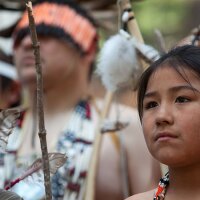Tules: Weaving Baskets, Boats, Decoys, and Houses


Tima Link, when she describes herself, says: “I’m not just a basket weaver, I’m a weaver.” In addition to baskets, she weaves cordage, nets, baby cradles, headdresses, bow strings, houses, and boats. Her words stuck with me when thinking about California Indian material culture, and how important one singular plant can be. This thought prompted a discussion between Tima and myself about an essential plant in Native California: tule.
Tule (pronounced too-lee) is one of those fascinating plants that has been a part of California Indian culture for millennia. It is one of the most versatile plants in California, and multiple species grow in different environmental regions. Two major species in California are the common tule (Schoenoplectus acutus) and California bulrush (Schoenoplectus californicus). In addition to Native North America, tule and its relatives are used around the world.
See how basketweaving becomes an essential part of Native American life and creativity on "Artbound" S9 E8: The Art of Basketweaving. Watch now.
Tule is related to papyrus, one of the most famous plants worldwide due to its use by the ancient Egyptians. Early surveyors to California lauded the potential of tule for paper products, due to its similarity to papyrus. The industry never took off, to the benefit of the plant, but those early accounts reveal the richness of the resource two centuries ago. Tule also thrives in South America. Indigenous communities in Peru, for example, have constructed boats out of tule for thousands of years. Today, artisans on Isla Del Sol in Lake Titicaca, among other places, still continue this practice.
Prior to contact, Native peoples across the land we now call California used tule to make houses, clothing, mats, baskets, and tools. Tule can be used to make a variety of baskets, from incredibly finely woven water bottles to rougher, open weave sifting baskets. Women from the various Chumash communities and other coastal peoples traditionally wore skirts made of tule. They would slice triangular bulrush into strips, forming them into skirts. Tima Link emphasizes the length of time it takes to process the materials and the amount of work it takes to produce one skirt.

Some communities use tule for baby cradles, and others for more unusual objects like the duck decoys traditionally used in the Sierras. These tule decoys would lure fellow waterfowl to a particular area, making them more accessible to hunters.
Kumeyaay cultural educator Stan Rodriguez recounts that his people, whose ancestral territory includes what is now San Diego, used to hunt whales in tule boats. Tongva and Chumash peoples used asphaltum as a caulking material for tule boats. Tongva artist L. Frank recently built a tule boat for Northwest Journeys, an annual intertribal event in Washington state where Native communities come together to build and sail traditional vessels. Tima relays that L. said that one of the best caulking methods was to use asphaltum mixed with tule piths. It makes the adhesive more flexible, allowing the boat to move in the water without cracking.
Tule used to thrive all over California. Essentially, as long as there was a waterway, there was tule. Tule can grow in any type of freshwater—along rivers, lakes, and estuaries, both near the coast and inland. Prior to contact, huge tule fields spanned the state. There used to be a large tule field in the center of Santa Barbara, which the Schmuwich Chumash called Kaswa' (place of the tule). Early photographs from the turn of the twentieth century reveal tule fields in Pomo territory near Clear Lake; community members used those tules to build traditional dwellings. The Pomo tribes still hold an annual boat festival on Clear Lake every July; community members say the tule there is not doing very well.

As a water-loving plant, tule has faced a multitude of threats due to drastic landscape changes over the past two centuries. For example, the former Tulare Lake in Central California, was named for the rows of tule plants that lined its shores. This lake used to be the largest freshwater body of water in California, home to tule elk (also named after the plant, one of the elk’s primary food sources), waterfowl, fish, and mussels. By the 1930s the lake had completely dried up, due to the conversion of land for agriculture and ranching in the Central Valley. The loss of Tulare Lake severely impacted the cultural traditions of the Yokuts peoples, who have lived in that area for thousands of years.
Tulare Lake is just one example. Across the state, most places where tule thrived have been developed. Areas where tules were once plentiful have now almost completely disappeared. The remaining areas of tule fields are often on land owned by state or federal parks, or by conservancies. In the few places where one can find tule, it is often difficult to access. Some of the few places that tule grows in anymore are undesirable, hard to reach spots, such as in steep ravines. Another huge environmental factor affecting tule is drought, which impacts tule even more significantly than other plants because it needs standing water to live in.

The health of the water also impacts tule. Although tule is mostly used as a building material, it is also a traditional food source. Native California peoples ate the white tuber portion of the root that goes down into the water. Today, the water that tule grows in is often stagnant and polluted. Tima laments the fact that she has never tasted tule because she doesn’t feel comfortable harvesting tule roots from the water they grow in. Of the state’s remaining tule fields, many are filled with garbage and sometimes inhabited by the homeless, who out of necessity pollute the water with excrement and waste.
Today, the types of cultural items people can make out of tule are being restricted by scarcity. Tima recounts that a decade ago it was still possible to easily gather enough tule to build a traditional house or a traditional boat. The tule plants were tall enough, green enough, and abundant enough. Now, the remaining tule is often too short and dried out. It is still possible to make items like baskets and mats, but a lot more difficult to make boats or houses.
Tule is just one example of how cultural activities are starting to disappear because of environmental change. A century ago, cultural traditions were disappearing for a different set of reasons. Native people across California suffered devastating population losses due to the mission system, the Gold Rush, and the targeted extermination efforts of the 19th century. Many who survived this genocide were then part of the boarding school era, where children were forbidden to speak their languages and practice their cultural traditions. Tima reflects that one hundred years ago, cultural practices disappeared because there weren’t enough people. Today the people have rebounded, but natural resources are now under pressure.
In response to these environmental pressures, community members are joining forces to help repair the health of tule in California. For example, many of the Southern California tribes have a strong working relationship with the University of California, Irvine. Biologists at the university are currently restoring a huge tule field on the campus, and are working with tribes to monitor the health of the field. The biologists look at factors that might be impacting the fields, such as monitoring blackbird nesting patterns, and in turn the tribal members keep an eye on the health of the plants, inspecting them for rot issues and other problems. Tima herself has developed an assessment form to monitor the plants, and teaches tending practices, applying her traditional ecological knowledge. Other similar collaborative partnerships also exist between tribes and conservancies and federal parks.
Tima, along with other community members, hopes to raise awareness about the plight of this culturally significant, versatile plant. She has a very real fear that the traditions of making cultural items from tule will completely disappear. For her community, the loss of tule would be a huge blow to tradition. When wrapping up our conversation, she asked the question: “what if Christmas trees weren’t doing well and no one could ever have a Christmas tree again?”
To me, that’s definitely food for thought on how we view our plants, our natural environment, and our connection to them. I hope it doesn’t come to that.
Banner: Contemporary tule gathering, photograph courtesy of Tima Link

Co-produced by KCETLink and the Autry Museum of the American West, the Tending the Wild series is presented in association with the Autry's groundbreaking California Continued exhibition.






